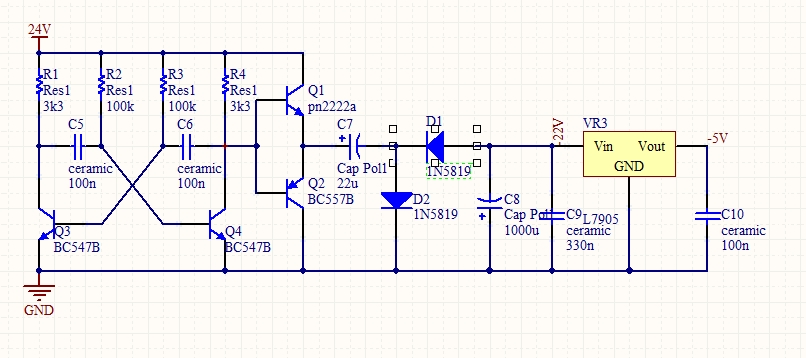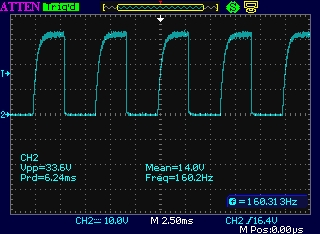poorchava
Advanced Member level 1
- Joined
- May 21, 2009
- Messages
- 429
- Helped
- 71
- Reputation
- 142
- Reaction score
- 71
- Trophy points
- 1,318
- Location
- Wrocław, Poland
- Activity points
- 4,780
In my project i need a low power negative voltage source for powering opamps. I want to generate negative voltage from positive by using inverting charge pump and then regulating the pump's output with 7905 IC. Below is the circuit schematic:

The pump generally works, it generates negative voltage and is capable of lighting a led with 2k2 resistor in series. The problem is with the regulator: it doesn;t work without sufficient load. Without load i've measured about -17V with respect to ground, while i've expected it to be regulated to -5V.
If load the regulator with a resistor of 270 ohm or so, the output voltage is correct, but otherwise it's not. Loading the regulator with 3k3 resistor make it's output about -9 volts.
I intend to power opamps only, which meansthat the regulator won't be loaded enough for it to generate proper voltage. Should i just attach 270ohm resistor in parallel with opamp power pins? And why is this circuit behaving in such a strange manner?
When i power the regulator from workbench adjustable power supply it works fine (always -5V), but when i power it from charge pump it does not. Whet is the proper solution of this problem?

The pump generally works, it generates negative voltage and is capable of lighting a led with 2k2 resistor in series. The problem is with the regulator: it doesn;t work without sufficient load. Without load i've measured about -17V with respect to ground, while i've expected it to be regulated to -5V.
If load the regulator with a resistor of 270 ohm or so, the output voltage is correct, but otherwise it's not. Loading the regulator with 3k3 resistor make it's output about -9 volts.
I intend to power opamps only, which meansthat the regulator won't be loaded enough for it to generate proper voltage. Should i just attach 270ohm resistor in parallel with opamp power pins? And why is this circuit behaving in such a strange manner?
When i power the regulator from workbench adjustable power supply it works fine (always -5V), but when i power it from charge pump it does not. Whet is the proper solution of this problem?
